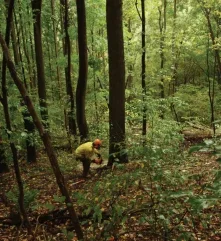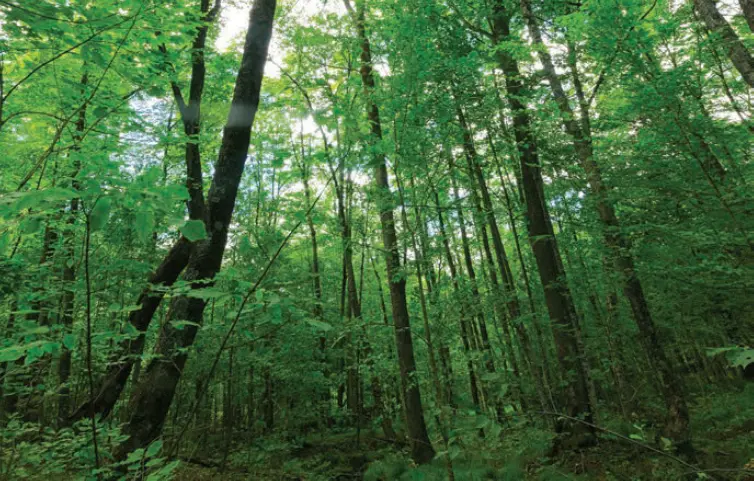
The American Hardwood Export Council (AHEC) is fully behind the aim of the upcoming EU Deforestation Regulation (EUDR) to help maintain the global forest, and the critical environmental services it provides. However, it says, the structure of US forest ownership, dominated by 9.5 million of small-scale private holdings, makes the proof of timber provenance to an exact plot of land demanded by the Regulation a hugely complex task for the American hardwood industry. Some say an impossible one. Consequently, AHEC is developing the sector’s own hardwood legality and deforestation-free validation system that is both feasible for it to use and aligns with EUDR objectives.
The EUDR is set to be implemented on January 1, 2025, and is designed to reduce the EU’s so-called ‘imported deforestation’. It encompasses seven designated forest and ecosystem risk commodities. Besides timber, these are palm oil, soya, coffee, cocoa, beef/cattle, and rubber. Any company placing these on, or exporting them from the EU, or non-SME businesses that trade in them, must undertake due diligence to ensure their production is not implicated in deforestation or forest degradation. Additionally, they must provide assurance they are legal in the country of origin.
Supplier countries will also be categorised under the Regulation as low, standard, or high risk of deforestation, with due diligence and the level of supply information interrogation required of businesses varying accordingly. This rating is being undertaken by the European Commission and the results will have a bearing on how often an EU operator is checked for compliance.

Just to this point, affected EU timber companies and their trade bodies say, compliance with the EUDR will be a major challenge, and there is lobbying to push back the implementation date to give business more time to prepare. The fact that supplier country benchmarking won’t be completed until after the Regulation is implemented, and, in the meantime, all will be designated standard risk, is adding to calls for a delay.
Then there is the additional consideration of the requirement on EU operators and traders to obtain precise geolocation coordinates for the plot of land where timber originated. A plot under the EUDR can cover thousands of hectares, so this is seen as being more straightforward for countries with extensive state-owned forests, or large-scale private forest concessions on state owned land, such as in most of the tropics. But, for those with widely fragmented ownership it is considerably more complex. And, although the US hardwood sector is not the only one of these, it is undoubtedly at the top end of fragmentation. While there are large scale private holdings, and state and federal forest, the largest part of the country’s hardwood forest belongs to over 9.5 million family and other private owners, many with plots of just a few hectares. So, mills have to source from multiple owners on an irregular basis. And given small holders can only supply small volumes and harvest intermittently, the hundreds of owners mills buy logs from one year, will be replaced by different ones the next. Providing and verifying geolocation co-ordinates for each log supplier, if it can be done at all, say mills, would be complex, arduous, and costly.

AHEC’s answer to the EUDR challenge is branded the Sustainable Hardwood Coalition System (SHC) and it’s currently backed by AHEC’s own funding. The SHC was initiated originally by AHEC to develop a US hardwoods sustainability certification system, but it was then decided specifically supporting EUDR compliance was the immediate priority.
Independent consultant George White, formerly head of the WWF Global Forest & Trade Network, is one of the lead coordinators in the system’s development. He said that, while the US has robust levels of forest governance and monitoring, and its timber sector is regarded in the international market as demonstrably sustainable, it’s been an exhaustive, demanding process.
Underpinning the SHC system are detailed illegality risk assessments of all 33 US hardwood producing states, undertaken by independent environmental management consultants Dovetail Partners.
“Dovetail are looking at all aspects of legality, assessing the situation on the ground against a framework of indicators and criteria developed by SHC. This covers the scope of EUDR requirements, which demand compliance with ‘all relevant’ regulations in the country of origin, and we also looked at the legality assessment frameworks of certification schemes and NGOs,” he said. “Dovetail’s task entails collecting and checking an enormous amount of background information and each state assessment will have 100-plus academic and legal references. They are casting the net wide, reaching out to state forest services, private companies, and NGOs. They are looking for systematic failings in governance in states, asking is there comprehensive law enforcement, does it work and is there corruption?”
By April 2024, 12 state assessments had been completed.
“Dovetail’s conclusion so far is that most states have almost zero illegality risk,” said Mr White. “One or two have some illegal logging, but that does not suggest systematic failing. It’s isolated cases and just a fraction of one per cent of all logging.”

Dovetail, he added, is telling SHC what it knew. “But it’s added reassurance to have this validated and broken down at such a granular level. In terms of addressing hardwood sector compliance with the regulation, Dovetail has probably gone wider than the EUDR requirement. In fact, the EU’s own benchmarking process will be done at a national level – the whole US – and cover all regulated commodities.”
Proof that timber is deforestation-free will be provided through forest monitoring by county in each hardwood state using the Sentinel satellite. American Green Consulting is currently undertaking a pilot project in Georgia to determine its efficacy and the frequency of monitoring required to give an accurate assessment of forest loss levels due to agriculture, if any.
“It’s a complex undertaking, requiring a certain level of resolution and detailed analysis,” said Mr White. “It’s one task identifying forest loss, another to determine whether that’s the result of normal forestry process and that reforestation will follow, or if it’s long-term deforestation. But initial signs from the pilot are positive and the indication is that annual monitoring of each county is the right level of frequency to get a picture of what’s happening.”

Added evidence that there is overall low risk of deforestation in the US comes from the World Resources Institute’s (WRI) Global Forest Watch satellite information-based online platform.
“It states that annually around 27,000ha of US forest land is converted to agriculture,” said Mr White. “Even if this was all concentrated in the 33 hardwood producing states, which comprise around 1,360 counties, that would be just 10-11ha per county per year. But it’s clearly not, so the average rate per county is probably more like 3-4ha – say 10 acres on average. That’s negligible risk.”
Rather than identify the individual property of land of log origin, mills using the SHC system would provide geolocation data for the county or counties in their supply chain. This stands up, says AHEC, because of the homogeneity of forest operations across a county and because the information will be backed up by the state legality risk assessments and county forest satellite monitoring, which prove negligible risk of any commodity-driven deforestation or degradation in line with EUDR definitions.
“It also avoids breaches of competition and commercial confidentiality rules that could potentially be caused by making small property provenance geolocation co-ordinates widely available,” said Mr White. “Mills naturally see the identity of their log suppliers as confidential to them.”
The SHC Chain of Custody (CoC) system is in development in parallel with the legality risk assessments and satellite imaging pilot. It’s a work in progress, but Mr White said it will be at the “simpler end of CoC systems”.
“It will provide the assurance that what goes in at one end of the chain and what comes out at the other can carry the same claim,” he said.
To monitor the operation of the CoC system, the SHC will draw on a sciencebased traceability frameworks, such as that being developed by World Forest ID and the US Forest Service. This uses such timber testing techniques as stable isotope analysis to provide proof of provenance to a level of accuracy similar to a typical US county.
AHEC points out that the wider environmental credentials of US hardwoods can be further verified using its life cycle assessment tool at www.americanhardwood. org. which, covers everything from global warming to marine eutrophication potential for consignments of key US hardwood species to any destination worldwide. Those consignments can also be accompanied by an American Hardwood Environmental Profile document. This includes LCA, plus provenance, legality and sustainability, information manufacturers can use to develop Environmental Product Declarations.

As for the SHC system, AHEC presented it to EU representatives and European Competent Authorities in April and their feedback will be used to evolve the system.
“We said this is what we can do in terms of meeting EUDR requirements, this is what’s possible,” said Mr White. “Currently there is a long queue of organisations going to the EU to tell them how difficult compliance will be. We may be one of few going to them with a positive, saying, ‘well, we can do this’.”
And whatever the EU response, he added, at the conclusion of the process, the US hardwood sector will have a unique validation system that enables it to make a legality and deforestation-free claim in markets globally.





